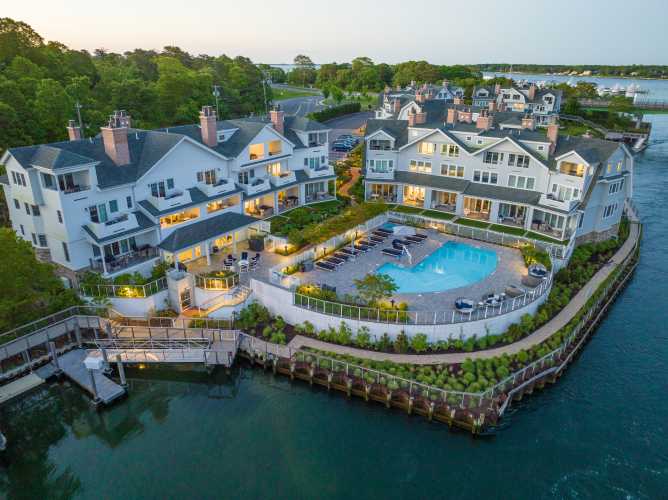Cars passing wide open spaces, slowing to admire the fields and farms, go by in greater numbers. Hiking trails worn with more foot traffic than they’ve seen in ages. Waterfront homes, once mostly dark this time of year, glow with light and activity from within.
The real estate boom that followed the exodus from New York City to Long Island’s East End during the coronavirus pandemic has done more than raise the off-season population, and local home prices, as seasonal residents moved here full time and summertime renters searched for something for the longer term. As property changed hands at a frenetic pace, demand increased, and so did revenues for the Peconic Bay Region Community Preservation Fund (CPF), sending numbers to record heights.
Fueled by a 2% transfer tax payable by the buyer on most real estate transactions in the five East End towns (Riverhead, Southampton, East Hampton, Southold, Shelter Island), CPF money goes toward the purchase and preservation of open space and farmland, active parks and recreation space, historic sites and water quality initiatives. In the first three-quarters of 2020 the CPF collected 45.5% more than it did a year ago, with $84.68 million coming to the coffers compared with $58.2 million for the same 2019 window. The highest year-to-date nine-month revenue total in its 21-year history means that preservation on the East End has a promising future at a time when promise is at a premium.
“It has provided a level of confidence that the area will retain its unique charm,” says Southampton Town Supervisor Jay Schneiderman, whose township saw the largest rise over last year, a 58% increase to $50.03 million. Each town collects its own CPF revenue, and spends it based on decisions of the town board, with public input in the process. “All these lands are publicly owned, they’re common land, so they become part of the value when you own in Southampton Town or anywhere within the Peconic region. In essence, if the Town owns the land and you own a property in the Town, then you own that land. It’s your property.”
Preserving the natural beauty and historic past, and the quality of life that comes with such efforts, goes hand-in-hand with creating the very value of the homes that fuel the CPF. And such effort must be ongoing. On the North Fork there is still a good deal of farmland to be preserved, notes New York State Assemblyman Fred Thiele, who introduced the CPF legislation more than two decades ago and remains one of its true champions. “On the South Fork, while they’re not done yet, they’re getting closer to finishing the open space/land preservation component,” he adds. “You’re seeing more and more interest, because of the increase in population, in acquiring land for active recreation, and there also seems to be more interest in historic preservation—the Pyrrhus Concer House in Southampton, money that was used for the façade of the movie theater in Sag Harbor, those kinds of projects.”
Over its lifespan, the CPF has brought in more than $1.2 billion, and the acquisition of the prior two decades is paying dividends now for a growing population spending more and more time here. “It’s a good thing we preserved as much as we have,” Schneiderman says, “because right now, that property we acquired has A, gone up in value, and B, we’d have a lot more homes and people, and there are only so many people the land mass can actually support, between traffic and the fragile environment.
“We’ve been very active in preserving our farmland and woodlands,” he continues, “keeping it from becoming subdivisions or large estates, so it’s a good thing we got what we did. And now it creates an opportunity for people to enjoy the outdoors, particularly in the age of COVID-19, where you’re looking for safe things to do other than stay in your house. So you enjoy nature, explore nature—we have incredible trails networks, incredible scenic vistas. All that sort of complements each other.”
In 2016, voters gave the okay for a provision that allows up to 20% of CPF money to go toward water quality initiatives, which addresses an issue that has become increasingly tenuous as the East End has grown. “An impact from development is issues we are seeing in our bays and harbors and our groundwater,” Schneiderman notes. “So our ability now to attempt to repair the damage that’s been caused by development, by using the Community Preservation Fund, I think moving forward that’s going to be a bigger and bigger focus on how the money gets used.”
In East Hampton, for example, Hook Pond has seen numerous toxic algae blooms in recent times, the result of groundwater runoff and septic system issues. The Town purchased a property on the pond with $4.8 million of CPF money last year that will, if all goes according to plan, become a site where the Town and East Hampton village will work together to restoring it to a natural state and have it serve as an educational site to show developers and home owners how to enjoy waterfront property while protecting the water.
Reimagining such spaces undoubtedly helps address challenges surrounding preservation and development. Yet the East End is also facing issues brought about by limiting the amount of space available.
“When you decrease the availability of developable land and you increase the value, you do run the risk of making it harder for the workforce to stay within a community, and that has been one of the biggest challenges,” Schneiderman says. “We’re a victim of our own success. We’ve done such a good job of preserving land, and we need to do a similar good job creating opportunity for the workforce to live within the community and enjoy these beautiful open spaces. The dark side of this is all the traffic as people commute in to meet the labor demands, and people living in substandard conditions.”
There have been efforts to build a similar fund that would support the development of affordable housing on the East End, which remains a work in progress. Yet it raises another question of what this influx of full-time—or fuller time, at least—residents will mean. The answer to that has ramifications on how CPF funds will be spent, where they will be needed, but its tendrils reach further. How many people the Hamptons and North Fork can sustain and support in a full-time capacity, for how long and how well, takes us into the realm of the unknown.
“For local government in particular, they have so much responsibility for land use,” Thiele says. “But for all levels of government, for all of us out here, the question is going to be, They’re staying, but how long are they staying? Is this a permanent shift in the demographics?”
“There’s going to be an impact on services, I think, that’s going to be costly, and you have to assess, what changes in services should we be making?” he continues. “Like after 9/11, it was kind of a 12-to-18-month phenomenon and then you started to see people drift back to the city. I think this one is longer, but is it permanent? I don’t think we know the answer to that yet. Those are the kinds of things you have to think about.”






















